False Starts: The Story of Vehicle-to-Grid Power

In 2001, a team of engineers at a then-obscure R&D company called AC Propulsion quietly began a groundbreaking experiment. They wanted to see whether an electric vehicle could feed electricity back to the grid. The experiment seemed to prove the feasibility of the technology. The company's president, Tom Gage, dubbed the system vehicle to grid" or V2G.
The concept behind V2G had gained traction in the late 1990s after California's landmark zero-emission-vehicle (ZEV) mandate went into effect and compelled automakers to commercialize electric cars. In V2G, environmental-policy wonks saw a potent new application of the EV that might satisfy many interests. For the utilities, it promised an economical way of meeting rising demand for electricity. For ratepayers, it offered cheaper and more reliable electricity services. Purveyors of EVs would have a new public-policy rationale backing up their market. And EV owners would become entrepreneurs, selling electricity back to the grid.
AC Propulsion's experiment was timely. It occurred in the wake of the California electricity crisis of 2000 and 2001, when mismanaged deregulation, market manipulation, and environmental catastrophe combined to unhinge the power grid. Some observers thought V2G could prevent the kinds of price spikes and rolling blackouts then plaguing the Golden State. Around the same time, however, General Motors and other automakers were in the process of decommissioning their battery EV fleets, the key component of V2G.
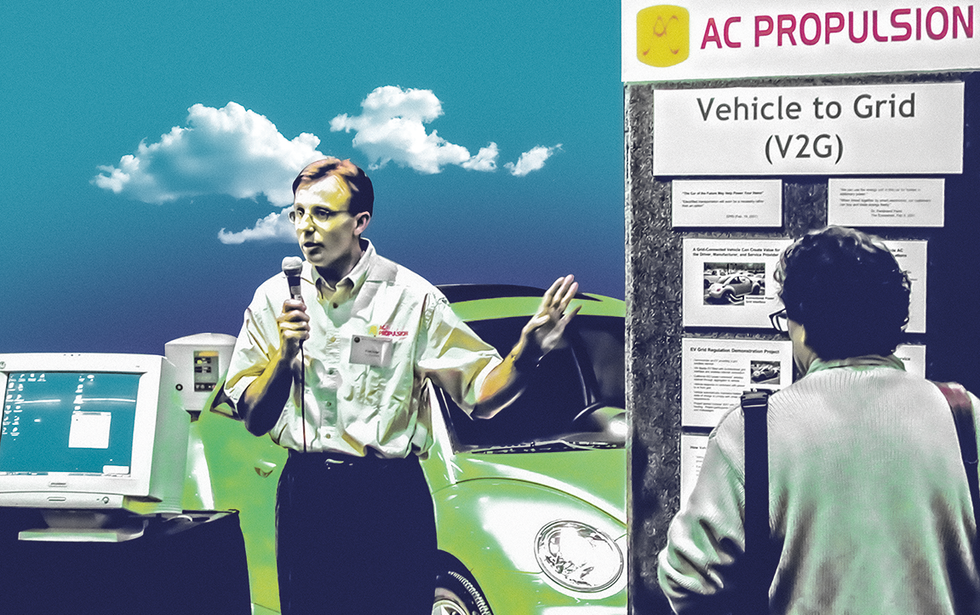 AC Propulsion's president, Tom Gage, explains the company's vehicle-to-grid technology at a 2001 conference in Seattle. Photo-illustration: Max-o-matic; photo source: Alec Brooks
AC Propulsion's president, Tom Gage, explains the company's vehicle-to-grid technology at a 2001 conference in Seattle. Photo-illustration: Max-o-matic; photo source: Alec Brooks
The AC Propulsion experiment thus became an obscure footnote in the tortuous saga of the green automobile. A decade later, in the 2010s, the battery EV began an astounding reversal of fortune, thanks in no small part to the engineers at ACP, whose electric-drive technology informed the development of the Roadster, the car that launched Tesla Motors. By the 2020s, automakers around the world were producing millions of EVs a year. And with the revival of the EV, the V2G concept was reborn.
Birth of the Power Plant on Wheels"
If a modern electronics- and software-laden car can be thought of as a computer on wheels, then an electric car capable of discharging electricity to the grid might be considered a power plant on wheels. And indeed, that's how promoters of vehicle-to-grid technology perceive the EV.
Keep in mind, though, that electricity's unique properties pose problems to anyone who would make a business of producing and delivering it. Electricity is a commodity that is bought and sold, and yet unlike most other commodities, it cannot easily be stored. Once electricity is generated and passes into the grid, it is typically used almost immediately. If too much or too little electricity is present in the power grid, the network can suddenly become unbalanced.
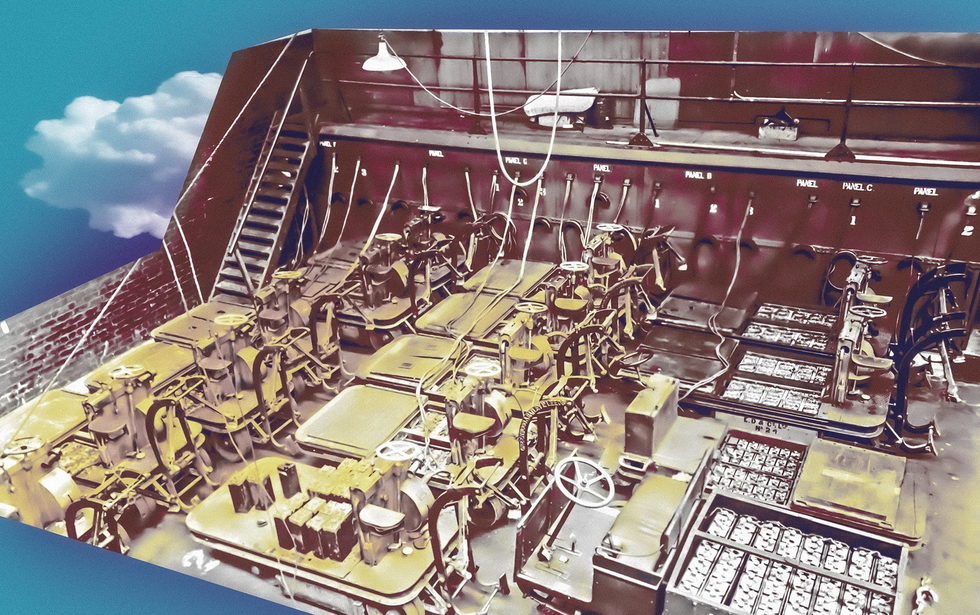 At the turn of the 20th century, utilities promoted the use of electric truck fleets to soak up excess electricity. Photo-illustration: Max-o-matic; photo source: M&N/Alamy
At the turn of the 20th century, utilities promoted the use of electric truck fleets to soak up excess electricity. Photo-illustration: Max-o-matic; photo source: M&N/Alamy
Some operators of early direct-current power plants at the turn of the 20th century solved the problem of uneven power output from their generators by employing large banks of rechargeable lead-acid batteries, which served as a kind of buffer to balance the flow of electrons. As utilities shifted to more reliable alternating-current systems, they phased out these costly backup batteries.
Then, as electricity entrepreneurs expanded power generation and transmission capacity, they faced the new problem of what to do with all the cheap off-peak, nighttime electricity they could now produce. Utilities reconsidered batteries, not as stationary units but in EVs. As the historian Gijs Mom has noted, enterprising utility managers essentially outsourced the storage of electricity to the owners and users of the EVs then proliferating in northeastern U.S. cities. Early utility companies like Boston Edison and New York Edison organized EV fleets, favoring electric trucks for their comparatively capacious batteries.
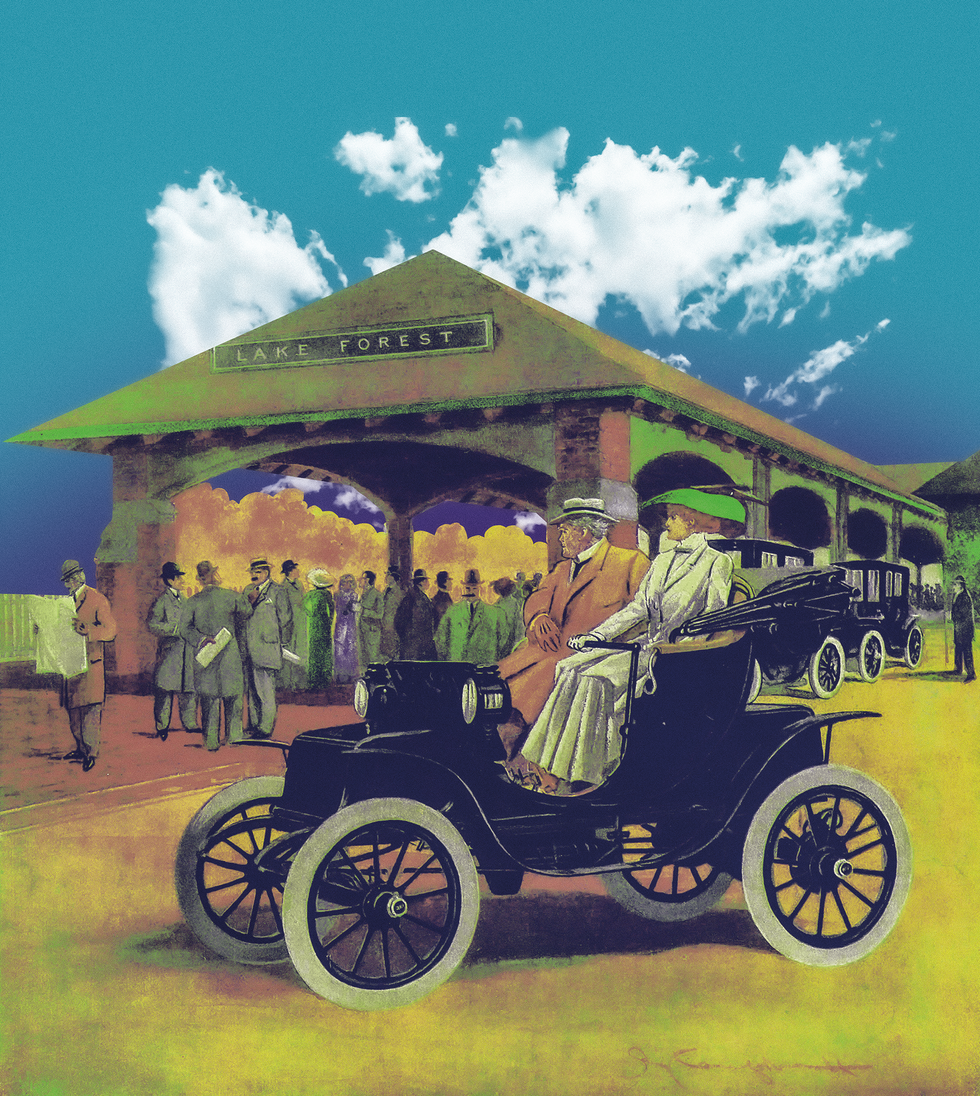 In the early years of the automobile, battery-powered electric cars were competitive with cars fueled by gasoline and other types of propulsion.Photo-illustration: Max-o-matic; image source: Shawshots/Alamy
In the early years of the automobile, battery-powered electric cars were competitive with cars fueled by gasoline and other types of propulsion.Photo-illustration: Max-o-matic; image source: Shawshots/Alamy
The problems of grid management that EVs helped solve faded after World War I. In the boom of the 1920s, U.S. utility barons such as Samuel Insull massively expanded the country's grid systems. During the New Deal era, the federal government began funding the construction of giant hydropower plants and pushed transmission into rural areas. By the 1950s, the grid was moving electricity across time zones and national borders, tying in diverse sources of supply and demand.
The need for large-scale electrochemical energy storage as a grid-stabilizing source of demand disappeared. When utilities considered storage technology at all in the succeeding decades, it was generally in the form of pumped-storage hydropower, an expensive piece of infrastructure that could be built only in hilly terrain.
The Origins of AC PropulsionIt wasn't until the 1990s that the electric car reemerged as a possible solution to problems of grid electricity. In 1997, Willett Kempton, a professor at the University of Delaware, and Steve Letendre, a professor at Green Mountain College, in Vermont, began publishing a series of journal articles that imagined the bidirectional EV as a resource for electricity utilities. The researchers estimated that, if applied to the task of generating electricity, all of the engines in the U.S. light-duty vehicle fleet would produce around 16 times the output of stationary power plants. Kempton and Letendre also noted that the average light vehicle was used only around 4 percent of the time. Therefore, they reasoned, a fleet of bidirectional EVs could be immensely useful to utilities, even if it was only a fraction the size of the conventional vehicle fleet.
 AC Propulsion cofounder Wally Rippel converted a Volkswagen microbus into an electric vehicle while he was still a student at Caltech. Photo-illustration: Max-o-matic; photo source: Herald Examiner Collection/Los Angeles Public Library
AC Propulsion cofounder Wally Rippel converted a Volkswagen microbus into an electric vehicle while he was still a student at Caltech. Photo-illustration: Max-o-matic; photo source: Herald Examiner Collection/Los Angeles Public Library
The engineers at AC Propulsion (ACP) were familiar with the basic precepts of bidirectional EV power. The company was the brainchild of Wally Rippel and Alan Cocconi, Caltech graduates who had worked in the late 1980s and early 1990s as consultants for AeroVironment, then a developer of lightweight experimental aircraft. The pair made major contributions to the propulsion system for the Impact, a battery-powered concept car that AeroVironment built under contract for General Motors. Forerunner of the famous EV1, the Impact was regarded as the most advanced electric car of its day, thanks to its solid-state power controls, induction motor, and integrated charger. The vehicle inspired California's ZEV mandate, instituted in 1990. As Cocconi told me, the Impact was bidirectional-capable, although that function wasn't fully implemented.
AeroVironment had encouraged its engineers to take creative initiative in developing the Impact, but GM tightly managed efforts to translate the idiosyncratic car into a production prototype, which rankled Cocconi and Rippel. Cocconi was also dismayed by the automaker's decision to equip the production car with an off-board rather than onboard charger, which he believed would limit the car's utility. In 1992, he and Rippel quit the project and, with Hughes Aircraft engineer Paul Carosa, founded ACP, to further develop battery electric propulsion. The team applied their technology to a two-seat sportscar called the tzero, which debuted in January 1997.
Electric Car tzero 0-60 3.6 sec faster than Tesla Roadsterwww.youtube.com
Through the 1990s and into the early 2000s, ACP sold its integrated propulsion systems to established automakers, including Honda, Volkswagen, and Volvo, for use in production models being converted into EVs. For car companies, this was a quick and cheap way to gain experience with battery electric propulsion while also meeting any quota they may have been subject to under the California ZEV mandate.
A Test of Vehicle-to-Grid TechBy the turn of the millennium, however, selling EV propulsion systems had become a hard way to make a living. In early 2000, when GM announced it had ceased production of the EV1, it signaled that the automaking establishment was abandoning battery electric cars. ACP looked at other ways of marketing its technology and saw an opportunity in the California electricity crisis then unfolding.
Traditionally, the electricity business combined several discrete services, including some designed to meet demand and others designed to stabilize the network. Since the 1930s, these services had been provided by regulated, vertically integrated utilities, which operated as quasi-monopolies. The most profitable was peaking power-electricity delivered when demand was highest. The less-lucrative stabilization services balanced electricity load and generation to maintain system frequency at 60 hertz, the standard for the United States. In a vertically integrated utility, peaking services essentially subsidized stabilization services.
With deregulation in the 1990s, these aggregated services were unbundled and commodified. In California, regulators separated generation from distribution and sold 40 percent of installed capacity to newly created independent power producers that specialized in peaking power. Grid-stabilization functions were reborn as ancillary services." Major utilities were compelled to purchase high-cost peaking power, and because retail prices were capped, they could not pass their costs on to consumers. Moreover, deregulation disincentivized the construction of new power plants. At the turn of the millennium, nearly 20 percent of the state's generating capacity was idled for maintenance.
 General Motors' Impact debuted at the 1990 Los Angeles Auto Show. It was regarded as the most advanced electric vehicle of its era.Photo-illustration: Max-o-matic; photo source: Alec Brooks
General Motors' Impact debuted at the 1990 Los Angeles Auto Show. It was regarded as the most advanced electric vehicle of its era.Photo-illustration: Max-o-matic; photo source: Alec Brooks
The newly marketized grid was highly unstable, and in 2000 and 2001, things came to a head. Hot weather caused a demand spike, and the accompanying drought (the beginning of the multidecade southwestern megadrought) cut hydropower capacity. As Californians turned on their air conditioners, peaking capacity had to be kept in operation longer. Then market speculators got into the act, sending wholesale prices up 800 percent and bankrupting Pacific Gas & Electric. Under these combined pressures, grid reliability eroded, resulting in rolling blackouts.
With the grid crippled, ACP's Gage contacted Kempton to discuss whether bidirectional EV power could help. Kempton identified frequency regulation as the optimal V2G market because it was the most profitable of the ancillary services, constituting about 80 percent of what the California Independent System Operator, the nonprofit set up to manage the deregulated grid, then spent on such services.
The result was a demonstration project, a task organized by Alec Brooks, manager of ACP's tzero production. Like Rippel and Cocconi, Brooks was a Caltech graduate and part of the close-knit community of EV enthusiasts that emerged around the prestigious university. After earning a Ph.D. in civil engineering in 1981, Brooks had joined AeroVironment, where he managed the development of Sunraycer, an advanced solar-powered demonstration EV built for GM, and the Impact. He recruited Rippel and Cocconi for both jobs. During the 1990s, Brooks formed a team at AeroVironment that provided support for GM's EV programs until he too tired of the corporate routine and joined ACP in 1999.
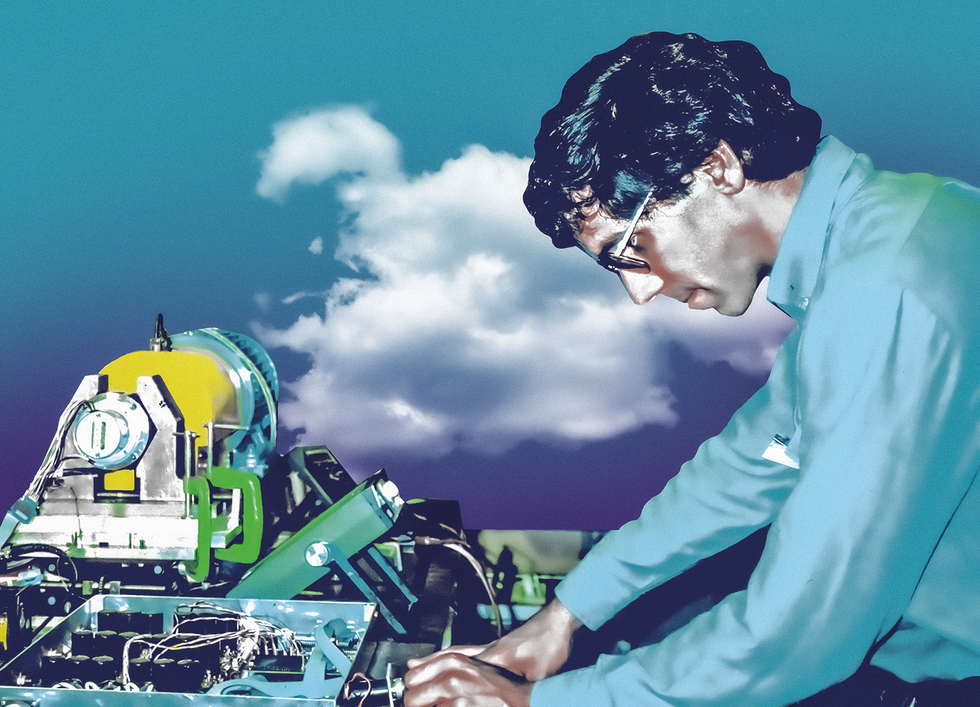 Before cofounding AC Propulsion, Alan Cocconi worked on Sunraycer, a solar-powered car for GM. Here, he's testing the car's motor-drive power electronics.Photo-illustration: Max-o-matic; photo source: Alec Brooks
Before cofounding AC Propulsion, Alan Cocconi worked on Sunraycer, a solar-powered car for GM. Here, he's testing the car's motor-drive power electronics.Photo-illustration: Max-o-matic; photo source: Alec Brooks
Working with Gage and Kempton, and consulting with the ISO, Brooks set out to understand how the EV might function as a utility resource.
ACP adapted its second-generation AC-150 drivetrain, which had bidirectional capability, for this application. As Cocconi recalled, the bidirectional function had originally been intended for a different purpose. In the 1990s, batteries had far less capacity than they do today, and for the small community of EV users, the prospect of running out of juice and becoming stranded was very real. In such an emergency, a bidirectional EV with charge to spare could come to the rescue.
With funding from the California Air Resources Board, the team installed an AC-150 drive in a Volkswagen Beetle. The system converted AC grid power to DC power to charge the battery and could also convert DC power from the battery to AC power that could feed both external stand-alone loads and the grid. Over the course of the project, the group successfully demonstrated bidirectional EV power using simulated dispatch commands from the ISO's computerized energy-management system.
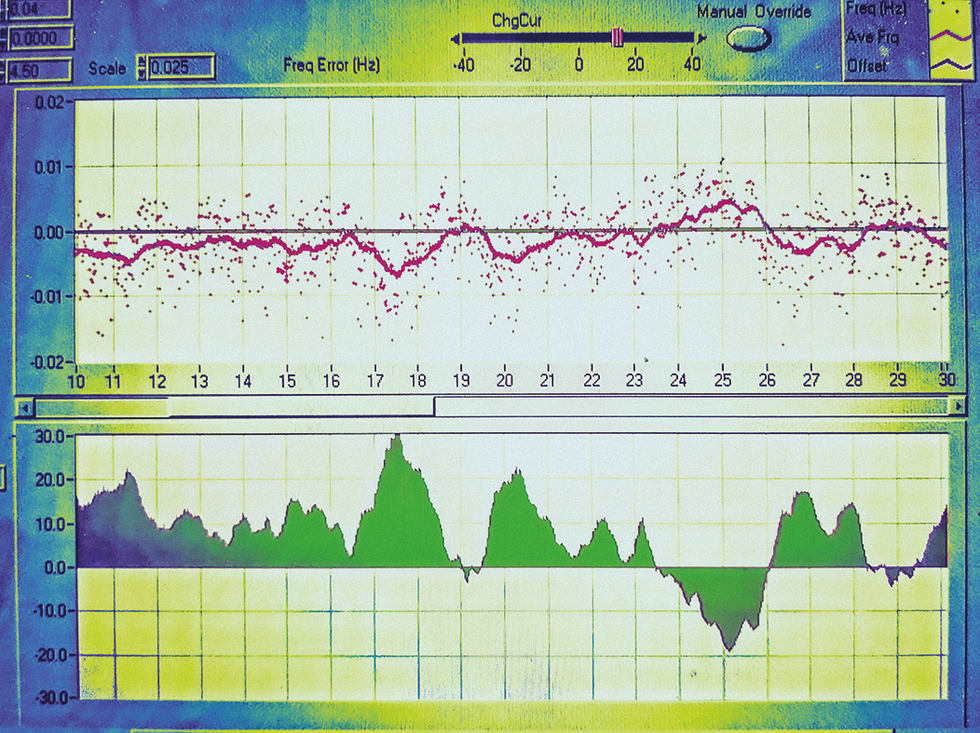 This pair of graphs shows how AC Propulsion's AC-150 drivetrain performed in a demonstration of grid frequency regulation. The magenta line in the upper graph tracks grid frequency centered around 60 hertz. The lower graph indicates power flowing between the grid and the drivetrain; a negative value means power is being drawn from the grid, while a positive value means power is being sent back to the grid.Photo-illustration: Max-o-matic; photo source: Alec Brooks
This pair of graphs shows how AC Propulsion's AC-150 drivetrain performed in a demonstration of grid frequency regulation. The magenta line in the upper graph tracks grid frequency centered around 60 hertz. The lower graph indicates power flowing between the grid and the drivetrain; a negative value means power is being drawn from the grid, while a positive value means power is being sent back to the grid.Photo-illustration: Max-o-matic; photo source: Alec Brooks
The experiment demonstrated the feasibility of the vehicle-to-grid approach, yet it also revealed the enormous complexities involved in deploying the technology. One unpleasant surprise, Brooks recalled, came with the realization that the electricity crisis had artificially inflated the ancillary-services market. After California resolved the crisis-basically by re-regulating and subsidizing electricity-the bubble burst, making frequency regulation as a V2G service a much less attractive business proposition.
The prospect of integrating EV storage batteries into legacy grid systems also raised concerns about control. The computers responsible for automatically signaling generators to ramp up or down to regulate frequency were programmed to control large thermoelectric and hydroelectric plants, which respond gradually to signals. Batteries, by contrast, respond nearly instantaneously to commands to draw or supply power. David Hawkins, an engineer who served as a chief aide to the ISO's vice president of operations and advised Brooks, noted that the responsiveness of batteries had unintended consequences when they were used to regulate frequency. In one experiment involving a large lithium-ion battery, the control computer fully charged or discharged the unit in a matter of minutes, leaving no spare capacity to regulate the grid.
In principle, this problem might have been solved with software to govern the charging and discharging. The main barrier to V2G in the early 2000s, it turns out, was that the battery EV would have to be massively scaled up before it could serve as a practical energy-storage resource. And the auto industry had just canceled the battery EV. In its place, automakers promised the fuel-cell electric car, a type of propulsion system that does not easily lend itself to bidirectional power flow.
EV Renaissance Revives Bidirectional PowerThe dramatic revival of the battery EV in the late 2000s and early 2010s led by Tesla Motors and Nissan revived prospects for the EV as a power-grid resource. This EV renaissance spawned a host of R&D efforts in bidirectional EV power, including ECOtality and the Mid-Atlantic Grid Interactive Cars Consortium. The consortium, organized by Kempton in conjunction with PJM, the regional transmission organization responsible for much of the eastern United States, used a car equipped with an AC-150 drivetrain to further study the use of V2G in the frequency-regulation market.
Over time, however, the research focus in bidirectional EV applications shifted from the grid to homes and commercial buildings. In the wake of the Fukushima nuclear disaster in 2011, for instance, Nissan developed and marketed a vehicle-to-building (V2B) charging system that enabled its Leaf EV to provide backup power.
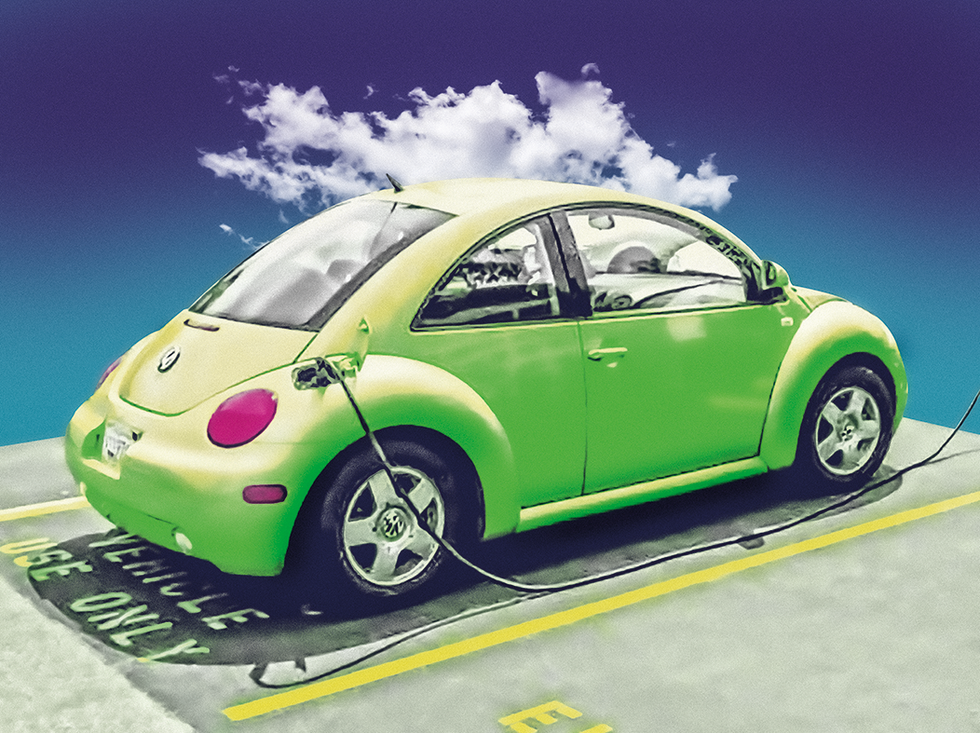 In 2001, AC Propulsion engineers installed an AC-150 drivetrain in a Volkswagen Beetle to demonstrate the feasibility of V2G technology for regulating frequency on the power grid.Photo-illustration: Max-o-matic; photo source: Alec Brooks
In 2001, AC Propulsion engineers installed an AC-150 drivetrain in a Volkswagen Beetle to demonstrate the feasibility of V2G technology for regulating frequency on the power grid.Photo-illustration: Max-o-matic; photo source: Alec Brooks
The automaker later entered an R&D partnership with Fermata Energy, a Virginia-based company that develops bidirectional EV power systems. Founded by the entrepreneur and University of Virginia researcher David Slutzky in 2010, Fermata considered and then ruled out the frequency-regulation market, on the grounds that it was too small and unscalable.
Slutsky now believes that early markets for bidirectional EV power will emerge in supplying backup power and supplementing peak loads for individual commercial buildings. Those applications will require institutional fleets of EVs. Slutzky and other proponents of EV power have been pressing for a more favorable regulatory environment, including access to the subsidies that states such as California offer to users of stationary storage batteries.
Advocates believe that V2G can help pay for EV batteries. While interest in this idea seems likely to grow as EVs proliferate, the prospect of electric car owners becoming power entrepreneurs appears more distant. Hawkins, the engineer who advised Brooks, holds that the main barriers to V2G are not so much technological as economic: Viable markets need to emerge. The everyday participant in V2G, he argues, would face the difficult task of attempting to arbitrage the difference between wholesale and retail prices while still paying the retail rate. In principle, EV owners could take advantage of the same feed-in tariffs and net-metering schemes designed to enable homeowners to sell surplus solar power back to the grid. But marketing rooftop solar power has proven more complicated and costly for suburbanites than initially assumed, and the same would likely hold true for EV power.
Another major challenge is how to balance the useful lifetime of EV batteries in transportation and non-vehicle applications. That question turns on understanding how EV batteries will perform and age in stationary-power roles. Users would hardly be further ahead, after all, if they substantially degraded their batteries in the act of paying them off. Grid managers could also face problems if they come to depend on EV batteries that prove unreliable or become unavailable as driving patterns change.
In short, the core conundrum of V2G is the conflict of interest that comes from repurposing privately owned automobiles as power plants. Scaling up this technology will require intimate collaboration between automaking and electricity-making, enterprises with substantially different revenue models and systems of regulation. At the moment, the auto industry does not have a clear interest in V2G.
On the other hand, rising electricity demand, concerns about fossil fuels, greenhouse gases, and climate change, and the challenges of managing intermittent renewable energy have all created new justifications for bidirectional EV power. With the proliferation of EVs over the last decade, more demonstrations of the technology are being staged for a host of applications-sometimes expressed as V2X, or vehicle-to-everything. Some automakers, notably Nissan and now Ford, already sell bidirectional EVs, and others are experimenting with the technology. Enterprises are emerging to equip and manage demonstrations of V2B, V2G, and V2X for utilities and big institutional users of electricity. Some ambitious pilot projects are underway, notably in the Dutch city of Utrecht.
Back in 2002, at the end of their experiment, the engineers at AC Propulsion concluded that what V2G really needed was a powerful institutional champion. They went on to make further important contributions to EV technology. Brooks and Rippel worked for the nascent Tesla Motors, while Cocconi continued at ACP until a cancer diagnosis led him to reevaluate his life. In the mid-2000s, Cocconi sold his stake in the company and devoted himself to aviation, his first love, developing remote-controlled solar-powered aircraft. The rebirth of the battery electric car in the 2010s and 2020s reaffirmed the efforts of these three visionary pioneers.
A strong V2G patron has yet to emerge. Nevertheless, the idea of an off-the-shelf energy storage unit that also provides transportation and pays for itself is likely to remain attractive enough to sustain ongoing interest. Who knows? The electric car might still one day become a power plant on wheels.
The author thanks Alec Brooks, Alan Cocconi, David Hawkins, David Slutzky, and Wally Rippel for sharing their experiences. Parts of this article are adapted from the author's new book, Age of Auto Electric (MIT Press, 2022).